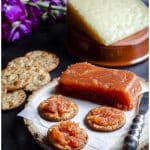Description
If you are lucky enough to find quince in your market, you must make this three-ingredient Membrillo. It is great with crackers, and manchego cheese, as a pastry filling and can also be used instead of jelly.
Ingredients
Units
Scale
- 2 large quince
- 1 1/2 cups of sugar
- 1 tbsp plus two teaspoons freshly squeezed lemon juice
- 3 cups of water
Instructions
- Peel quince and cut in half. See Note 1.
- Remove seeds and place them in a small piece of cheesecloth. Create a pouch and tie it with cooking twine. See note 2
- Cut quince into 1.5" chunks
- In a large saucepan combine quince, sugar, lemon, water, and seed pouch and stir.
- Bring to a boil, lower the heat until it comes to a low boil (where small bubbles come rapidly to the water surface) for 45 - 60 minutes or until all the water has evaporated, the quince has turned into an orange color and the quince is very soft. Stir often with a wooden spoon.
- Let it cool, take out the seed pouch, and puree the quince mixture with an immersion blender or in the food processor until smooth.
- Spread the quince purée into a small glass rectangular, square, or round shallow baking dish for which you have a lid.
- Cover and refrigerate for 3 hours or more until the membrillo is set and you can cut it with a knife.
- Serve over crackers, plain, with Manchego or sharp cheddar cheese, or use it as a pastry filling
Notes
-
- Quince is hard, use a vegetable peeler to peel it.
- Quince and its seeds are high in pectin which helps the membrillo come together as a paste. Our grandmother used to make quince paste and include the seeds while cooking. So we are following our family tradition. Make sure you put the seeds in cheesecloth so you don't have to fish them out later.
- Quince is a fruit that looks like a cross between an apple and a pear.
- If the quince is very green it will have a light furry layer, that will come off by washing the fruit. A more yellowish quince means that is riper, it will take less time to cook, but it can still not be eaten raw.
- Quince must always be cooked, it cannot be eaten raw. Raw quince has a rough grainy texture even though it has a slightly floral aroma.
- It is not always easy to find If you are lucky enough to find it, you must try this membrillo recipe.
- Try asking the produce manager of your local supermarket for quince or look for it in farmer's markets, Asian or Middle Eastern markets, or specialty stores. We have also found online stores selling quince but in large quantities.
- Dulce de membrillo looks like is guava-like paste, but tastes very different.
- Dulce de membrillo is made, by cooking the fruit in sugar and a little bit of lemon. Because of its pectin content, dulce de membrillo holds its shape like guava paste and can be cut with a knife.
- When cooked the creamy white quince turns a beautiful reddish-pinkish color
- You can find made-in-Spain dulce membrillo in specialty supermarkets, gourmet food shops, and online.
- In Spain, membrillo is eaten with Manchego cheese. The sharpness of the Manchego cheese and the sweetness of the membrillo complement each other beautifully.
- Membrillo can also be added to soft creamy cheese, to yogurt or as a pastry or pie filling.
This post was originally published on October 23, 2019
- Prep Time: 3 hours 15 mins
- Cook Time: 45 mins
- Category: Dessert
- Method: Stove top
- Cuisine: Spanish
Nutrition
- Serving Size: 1 tbsp
- Calories: 67
- Sugar: 15.6
- Sodium: .5
- Fat: 0
- Saturated Fat: 0
- Unsaturated Fat: 0
- Trans Fat: 0
- Carbohydrates: 17.4
- Fiber: .2
- Protein: 0
- Cholesterol: 0
